How To Make Money Tree Grow Bigger
One of my most favorite houseplants is my Money Tree (Pachira Aquatica). It was given to me by my grandmother right after I got married. When she brought it to me, it was probably only about 24″ tall, but now, it is almost as big as I am (and I am almost six feet tall!) So what is the secret?
How can you make your Money Tree grow faster and taller? To encourage your Money Tree to grow big quickly, you'll need to make a few adjustments to your basic care routine. With ideal growing conditions, fertilizer, pruning, and a few tools, your Money Tree can keep growing and growing and growing.
I've compiled a list of my top nine tips for encouraging bigger and taller Money Trees. If you've got a small tree that you're hoping will turn into a giant, follow along with these instructions and give your Money Tree exactly what it needs to thrive.
How Fast Do Money Trees Grow?
Compared to many other houseplants, Money Trees grow quite fast. It is not unusual to see your Money Tree put out new leaves every few weeks during the growing season. When they are saplings, Money Trees can grow as quickly as 24″ in a single year. That's fast!
To encourage this kind of rapid growth, you'll need to be diligent about caring for your Money Tree and ensuring that it has everything it needs to thrive. Adequate water, proper sunlight, and nutrients are vital to keeping your Money Tree growing quickly.
Money Trees in the Wild vs. Money Trees as Houseplants
In their natural habitat, Money Trees, also known as Malabar Chestnuts, will develop much differently than when they are kept as houseplants. Natives of the swamplands of Central and South America, wild Money Trees can exceed heights of 60 feet.
Along the riverbanks where the Money Tree is found in nature, these trees are able to spread out their root systems, giving themselves support and seeking out nutrients along the way. This is why they can continue to grow to massive heights. In these conditions, they will even flower and produce seeds, a type of chestnut that can be roasted and eaten.
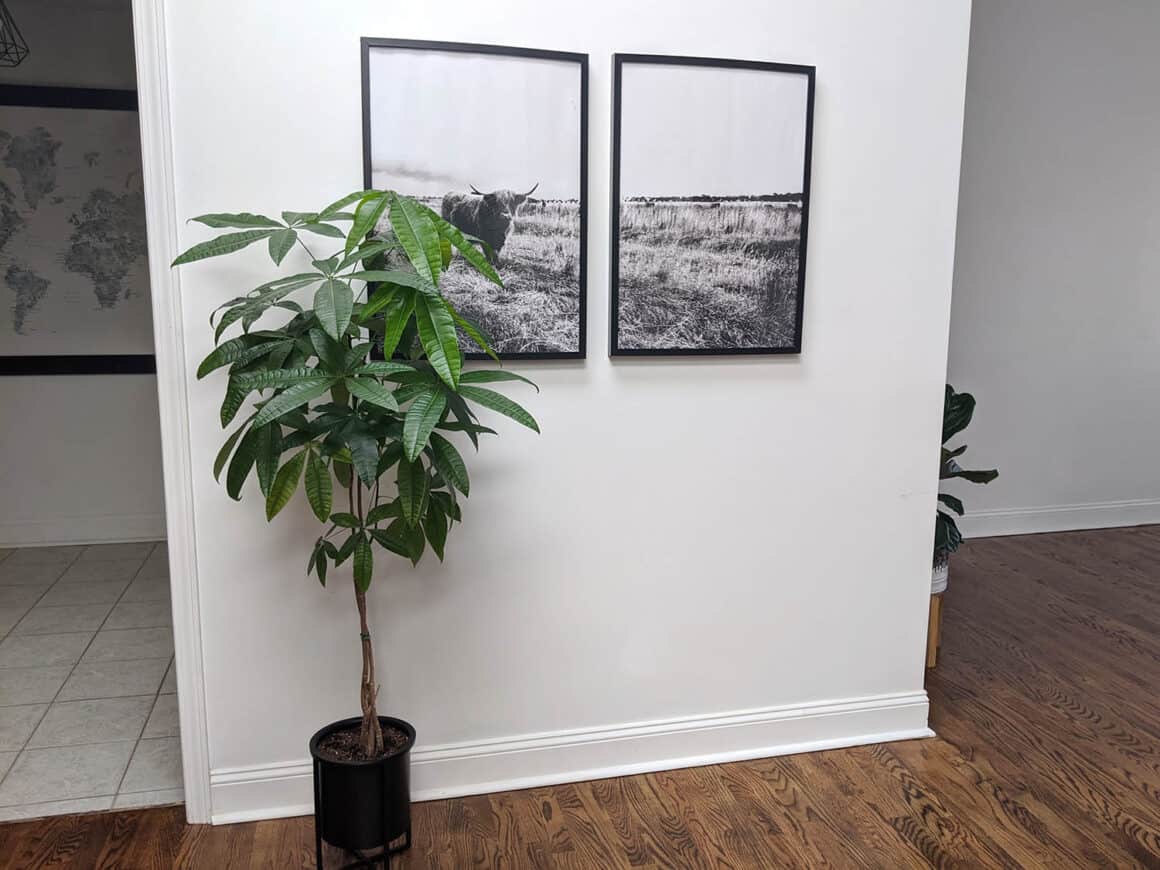
In the home, however, these plants will rarely exceed 8 feet tall. Getting a Money Tree to that height requires a lot of love and care, so if your goal is to grow your tabletop tree to one that size, you should plan to follow these instructions below.
Remember: Time of Year is Important
If you haven't seen any new growth on your Money Tree in a few months, don't panic. Depending on the season, Money Trees can grow faster or slower. No new growth may just mean that your tree is dormant.
In nature, all plants have a season where they are growing and a season where they are dormant. Plants use this dormant period to enter a state of metabolic inactivity and slow their growth to conserve energy. This stage will continue until temperature rises, and conditions are better for fostering new growth.
When we move plants indoors, we keep them at a constant temperature and moisture level, but we do not negate their growing season. Most houseplants can sense the shift in temperature, humidity, and weather around them. Even indoors, they have a cycle of growing seasons and dormancy.
The growing season takes place during the warmest months of the year. Growing season is denoted by the last and first frosts of the year, and for most of us occurs from spring to early fall. During this time, you will see faster growth from your plant as it turns sunlight into energy more quickly.
When your Money Tree is dormant, your care should be altered. It will generally need less water in the winter and shouldn't be fertilized during this period. It is, however, the ideal time to do any structural pruning.
If you haven't noticed new growth on your Money Tree, it may be because it is dormant. Don't worry! It will begin growing again when the days start to become longer, and the temperatures warm up.
If you don't believe your Money Tree is dormant, there may be some other thing restricting its growth. For eight reasons why your Money Tree may not be growing, read this article.
Things Plants Need to Grow
Almost all plants need the same things to grow: water, carbon dioxide, sunlight, and nutrients. Given these in the right amounts, your plant will be pleased and will put out new growth for years to come.
Water and sunlight are vital to photosynthesis, which is necessary for any plant to live and grow. Photosynthesis allows plants to convert carbon dioxide and water into food for themselves and oxygen for us.
Nutrients, such as potassium, nitrogen, phosphorus, and calcium, are also essential to plants. Like in humans and animals, these nutrients encourage growth and help the plant fight off pests and diseases. Too much or too little can damage the plant and prevent growth.
While plants can get sunlight and water virtually for free, for indoor plants, nutrients can be depleted from the soil and should be replenished semi-frequently.
Money Trees need adequate room to grow. Being confined to a small container will limit the space that a plant's roots have to expand, making it difficult for the plant to take up water and nutrients from the soil. Running out of room in the pot also tells the plant that there's no more space for it to grow.
How To Make Your Money Tree Grow Bigger Faster
Now that we've got that out of the way, let's get you what you came for. Below you'll find the top nine tips that I use to grow large Money Trees. But remember Money Trees won't like major changes to their routine or environment. Pick just one or two of these tips and work on them, then give your Money Tree time to adjust before continuing on.
Tip #1: Give Your Money Tree Plenty Of Indirect Sunlight
Like most plants, Money Trees need sunlight to grow properly. A happy Money Tree is one that has access to bright, indirect sunlight. Areas that have this type of light are generally near windows, but not up against them.
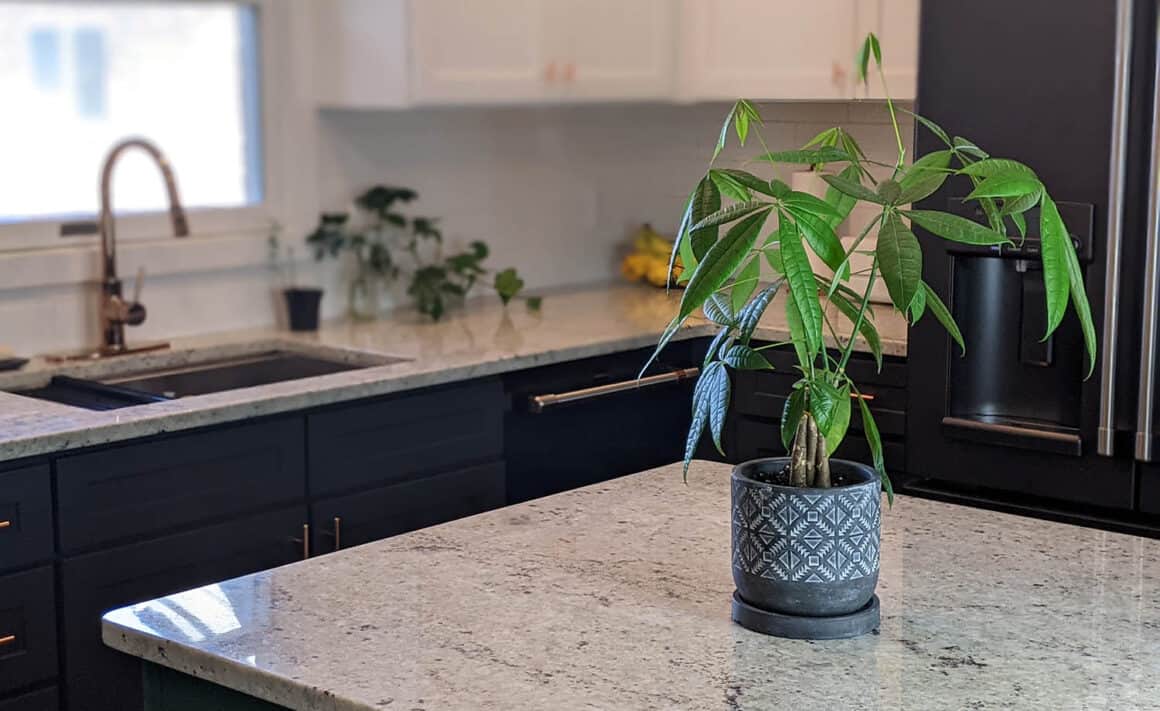
A Money Tree put in direct sunlight will not thrive. These plants don't do well in areas that have direct sunlight because it can actually burn the leaves, causing them to turn yellow or brown, and eventually fall off. This is called leaf-scorch and can seriously harm your plant and stunt its growth.
Any stressful situation takes energy from what your Money Tree could be using for new growth. Direct sunlight harms the leaves, and plants that are less-than-healthy require more energy to recover. Keep your plant in an area out of the direct sun and avoid the energy-suck from your plant.
Money Trees can exist in spaces with low light – but they will not grow to their full potential in these conditions. For best results, place your Money Tree near a bright, south-facing window, far enough back to protect its foliage from the sun.
Tip #2: Water Your Money Tree Properly
Watering habits are insanely important when it comes to keeping plants alive. I would say 90% of all houseplant troubles come from improper watering habits. So how can you avoid an unpleasant outcome?
Only water your Money Tree when it needs it! You may think that I am oversimplifying some complex process, but it really is that easy. Too little water will stunt your plant's growth, and too much water will kill it.
To check if your Money Tree needs water, you'll want to keep an eye on the soil's moisture level. Stick your finger into the top one to two inches of soil and feel for wetness. If the soil is dry, it's time to water. If it is still damp, wait a few more days and check again.
If the thought of knowing when to water your tree has you feeling stressed, take the guesswork out of the equation with a moisture meter. Moisture meters are small devices that are inserted into a houseplant to give you an accurate read on the level of water in the soil. If you have a
When it is time to water, do so thoroughly. You'll want to water your Money Tree until about twenty percent of the water you put in, flows out through the drainage hole in the bottom of the planter. This will ensure that water has been able to reach all areas in the soil and roots and will keep your plant the happiest. Less frequent, thorough waterings are much better for houseplants than shallow, frequent waterings.
One final note on watering: Never let a Money Tree sit in standing water! Empty out the saucer beneath the plant if it has accumulated water. Overly wet soil leads to root rot, and root rot is bad news for Money Trees.
Tip #3: Water Your Money Tree With Rainwater
Unless filtered, tap water tends to carry heavy metals and other contaminants. These things can damage the roots of most plants, including Money Trees. While it is not as easily accessible, watering your Money Tree with rainwater will keep it at its healthiest.
If you have ever noticed a white, chalky ring around the pot that your plant is in, this is due to calcium build-up, which is caused by using tap water. And while tap water won't kill your plant, this same build-up is most likely in the pores of your plant.
The easy and free fix for this is to collect rainwater! It can be used for most plants and has naturally-occurring nutrients that are often filtered out in distilled water. This is perfect for your Money Tree because it eliminates the build-up that can potentially stunt growth while also introducing extra nutrients that encourage your plant to expand. For more on the benefits of watering with rainwater, click here.
Depending on where you live, there may be some local ordinances surrounding rainwater collection. Just to be safe, check out the laws in your area before collecting rainwater.
Tip #4: Fertilize Your Money Tree During The Growing Season
Fertilization is essential for all plants and is especially important when trying to grow a big Money Tree. It's also an easy way to ensure that your Money Tree is getting the nutrients needed to grow and thrive.
Because Money Trees are dormant in the winter months, that is not the time to fertilize. They won't be able to absorb the nutrients readily, which can actually lead to issues with fertilizer burn.
Instead, Money Trees should be fertilized two to three times during the spring and summer. But don't overdo it and fertilize too much! Excess fertilizer is harmful to houseplants.
To fertilize your Money Tree, dilute a liquid plant food to half strength and water your plant during its regular watering time. Keep an eye on it for any signs of distress, including drooping or yellowing leaves.
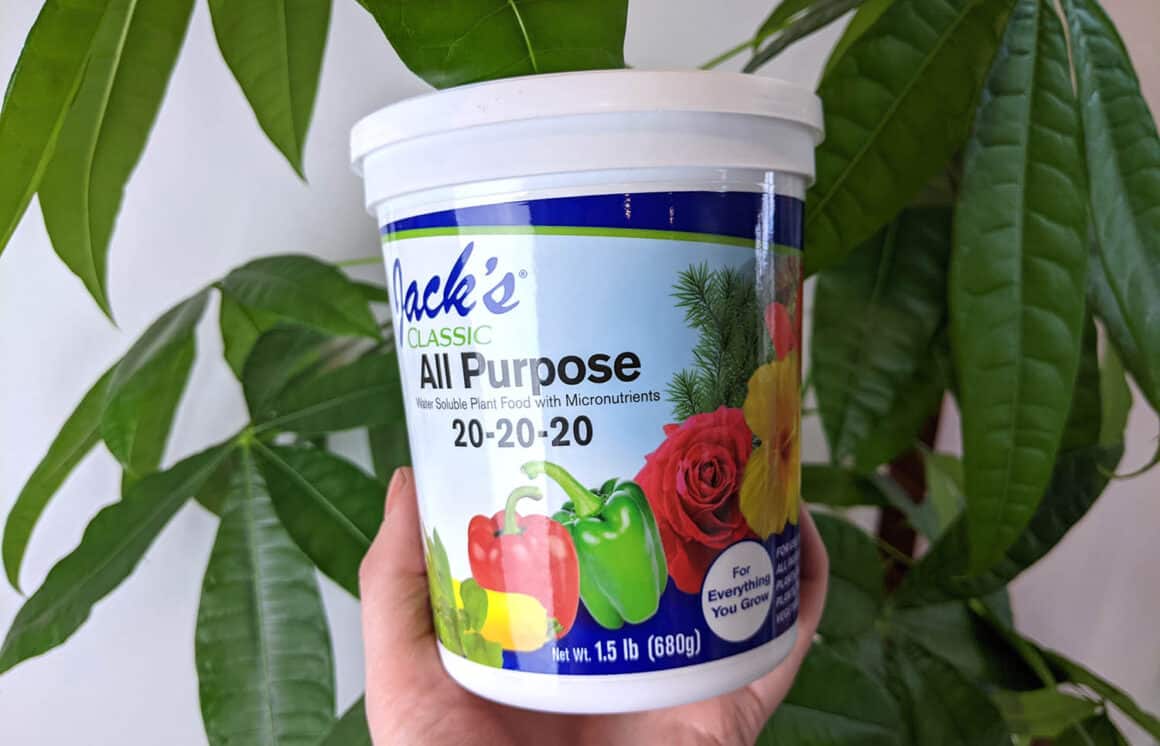
I use Jack's All-Purpose 20-20-20 Houseplant Fertilizer on my Money Tree, but any balanced fertilizer will do. Remember to dilute the fertilizer to half strength. When in doubt, it's best to add too little rather than too much. You can always add more, but once you've added fertilizer in, it's hard to remove it.
If you notice yellowing or browning leaves after fertilizing your Money Tree, take the plant to the sink or shower flush the leftover fertilizer from the soil. By running the water over your soil and allowing it to flow through the drainage hole, you will flush the soil and keep the damage from getting worse.
For more of my recommendations on fertilizing Money Trees, check out this article.
Tip #5: Give Your Money Tree Room To Grow
A major part of encouraging a Money Tree to grow is giving it the space to do so. If your Money Tree's roots don't have room to expand, they won't be able to continue growing, and eventually, your plant won't grow at all. To avoid this, your Money Tree should be repotted at least every two years, though it may be needed once a year if its growth is significant.
When transplanting a houseplant, you should ideally go up about one pot-size at a time. Any larger than that and your plant can run into problems. Planters that are too big for a Money Tree will take longer to dry out between waterings, and having wet roots for too long can cause root rot.
Your tree should be replanted in early spring, just before the growing season starts so that it has plenty of nutrients and room to grow. Plus, refreshing potting soil is an excellent way to provide your Money Tree with additional nutrients to encourage growth.
But be careful. Plants can experience shock from being replanted, so have everything prepared in advance and go quickly. After replanting, return your Money Tree to the spot it was originally in and watch it for signs of distress, including drooping or yellowing leaves.
Tip #6: Prune Your Money Tree Properly
This seems counterintuitive, but when done properly, pruning can actually encourage growth in Money Trees. But before we get into it, there are two types of pruning, and it's important to know the difference.
Maintenance pruning involves routinely cutting new growth or small branches and stems from your Money Tree. This pruning can be done all year long and will encourage your Money Tree to focus on growing out rather than up, creating a fuller appearance.
Structural pruning involves cutting the roots and larger portions of the actual tree. Structural pruning should only be done in the winter, while the tree is dormant. For people interested in keeping a smaller Money Tree, this is a great way to keep the roots a reasonable size.
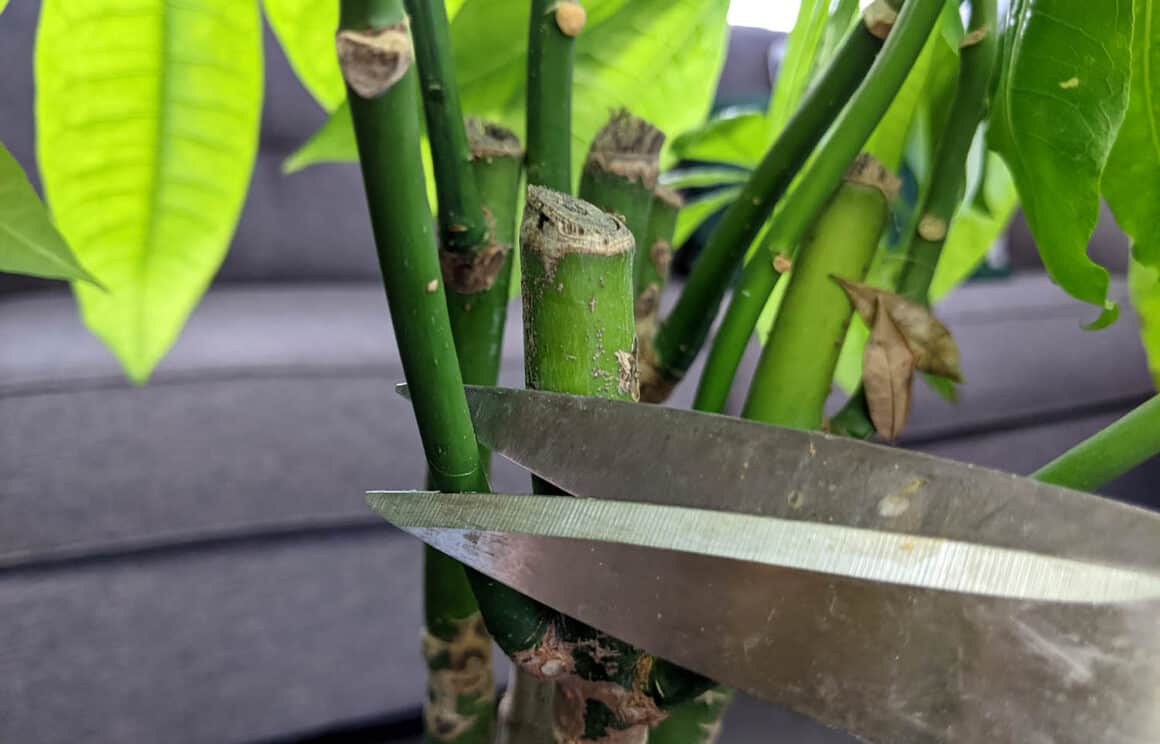
Regularly doing maintenance pruning, especially in areas that you would like to encourage growth, can be a great way to get a larger Money Tree. When you remove a section of the plant, it will free up energy and give your plant a boost. While it seems a bit backward, removing unwanted branches and leaves can encourage new growth and keep your tree looking tidy.
For more information on pruning Money Trees, read this article.
Tip #7: Increase the Humidity Around Your Money Tree
Money Trees thrive in humidity as they are naturally tropical plants. Low humidity levels can actually keep your Money Tree from growing. Remember, a stressed-out tree is an unhealthy tree. Anything that causes your plant to have to adjust is taking energy away from new growth.
If you live in an arid area, like the desert, or in an especially dry house, you should try to make accommodations for your Money Tree. Not sure about your humidity levels? A small hygrometer can measure the relative humidity in your home and give you a good idea of which rooms are best for your Money Tree.
When it comes to raising the humidity in a room of your home, humidifiers are the best option. My large Money Tree sits next to a humidifier, and I could not believe the improvement the added humidity made in the foliage of my plant. Less than a week after placing the humidifier near my Money Tree, my tree looked healthier than it had ever been.
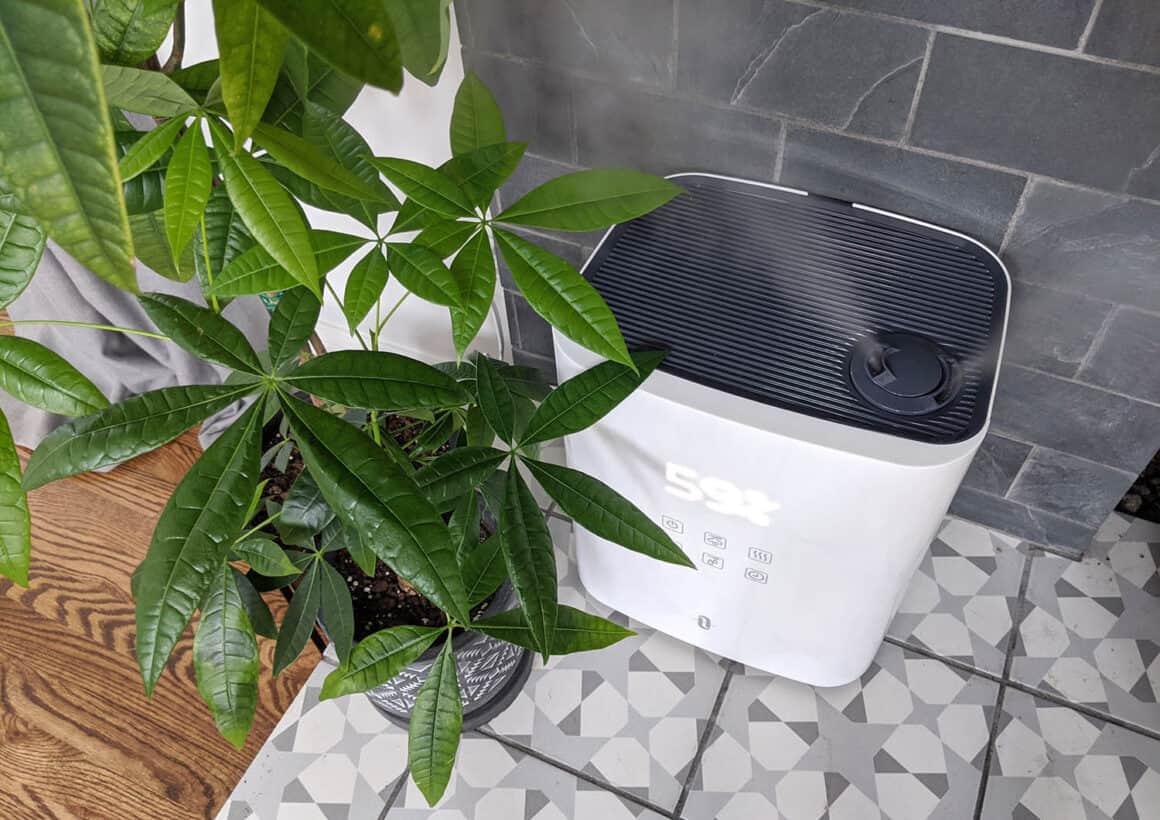
If you're interested in humidifiers but don't know where to start, I wrote an article outlining which ones I use and why I chose them. For more information on the best humidifiers for Money Trees and other houseplants, read this.
Money Trees also benefit from being misted and showered. Misting is as simple as lightly spritzing your Money Tree with room temperature water several times a week. Showering involves putting your Money Tree in the shower and letting gentle, lukewarm water run over it for a little while. Showering provides humidity and water and also cleans the leaves, much like rain would in the wild.
Some rooms in your home, like kitchens, bathrooms, and basements, will have higher humidity levels than others and will be better suited for your Money Tree. Measure the humidity levels in each room with a hygrometer and then relocate your plant to a better space for higher humidity.
Tip #8: Stake Your Money Tree When The Time Is Right
My Money Tree went through a middle-school-like-awkward-state about three or four years into my owning it. The height it was reaching was outgrowing the structure of the initial braid, and the thin trunks were having a hard time supporting the new growth of the tree.
I had already cut the tree back a few times to help the growth spread out instead of up, but I knew I did eventually want the tree to be a large, statement piece in my living room.
I decided to put a stake (which in my case was literally just a dowel rod with bread ties) into the soil and secure my Money Tree to it. I was worried that the plant would always need to be staked, but it didn't. Eventually, the trunk bulked up and was able to support the weight of the new top-heavy growth.
After about a year, I removed the stake. Once my plant made it over that hump, it hasn't needed any assistance since. If you are worried that the new growth on top of your Money Tree might cause your thin trunk to bend or snap, stake it up and help it support its own weight until it can do so on its own.
Tip #9: Invest In A Grow Light For Your Money Tree
Grow lights are an excellent choice for anyone concerned about the amount of light their Money Tree is receiving. Indications that your tree isn't getting enough light include yellowing leaves and a lack of growth.
Grow lights are easy to set up, reasonably priced, and come in various shapes and sizes. Much of what you need is dependent on your home and plants, so plan to do your research.
If you live in an area that doesn't get much sunlight (especially during the winter) or in a home with very little natural light, grow lights are fantastic. They mimic the light your plant would receive from the sun and can be adjusted to meet almost any needs. If you're interested in a grow light, read this article for my suggestions.
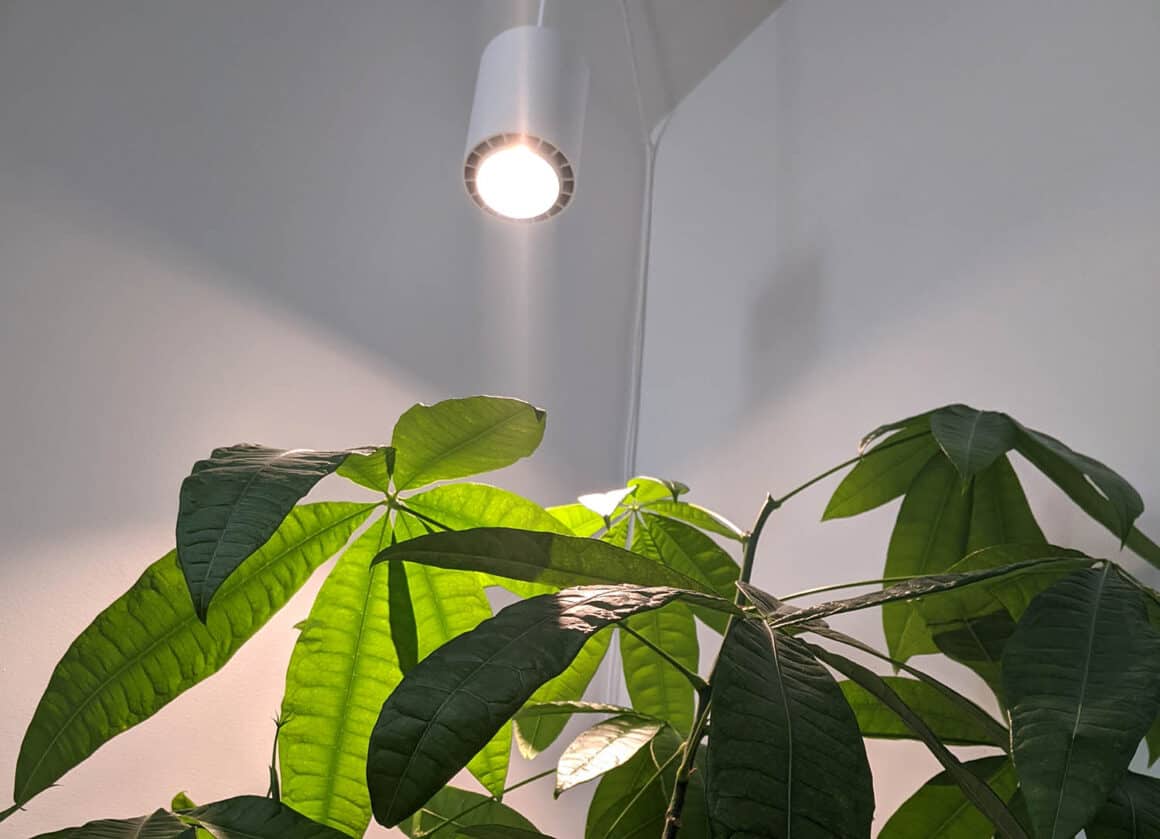
When you get your grow light, you shouldn't put the Money Tree directly beneath it, as it can burn the tree much like direct sunlight. Putting your Money Tree within a few feet of the lamp, which can be positioned over plants that do need direct light, is the best way to avoid burning.
Grow lights should be left on for 12-15 hours to simulate sunlight, though you should be conscious of how much light your plants need. The easiest way to regulate putting the light on at the right times is to invest in a lamp timer.
These are great for the winter months, when sunlight is limited, and are something to consider if you have plants that struggle when the days get shorter.
A Few Final Thoughts to Consider
The most significant factor in growing tall Money Trees is time. The tree my grandmother brought me is probably ten years old now. Even though these trees grow relatively quickly, especially compared to slow-growers like my ZZs, reaching considerable heights takes time.
If you want a massively tall Money Tree, you'll want to purchase one that already has some height to it. Some Money Trees are pruned to stay small, making it much more challenging to grow tall. If the braided trunk of your Money Tree is only six or eight inches tall, you may have a harder time getting the small trunk to support a large tree.
The trunk of my tall Money Tree was probably about two feet tall. But I've slowly unbraided most of it to let it reach and grow. Remember, though, I've had this plant for nearly ten years, so this is not something that can happen overnight.
As with any plant, getting enough light and water can make a huge difference in how quickly it grows. Be sure to check your Money Tree regularly for signs that it is unhappy, including browning or yellowing leaves and a wrinkled trunk. These can be indications that one of these conditions isn't right.
Now you've got the facts! Take what you learned and choose a few of these tips to try with your Money Tree. Experiment until you find something that is working for you, but remember: too much change isn't good for a Money Tree. When it comes to houseplants, slow and steady wins the race. Make any changes gradually and allow your plant time to adjust to its new care routine and environment.

How To Make Money Tree Grow Bigger
Source: https://thehealthyhouseplant.com/9-tips-for-encouraging-bigger-taller-money-trees/
Posted by: savoiecapand.blogspot.com

0 Response to "How To Make Money Tree Grow Bigger"
Post a Comment